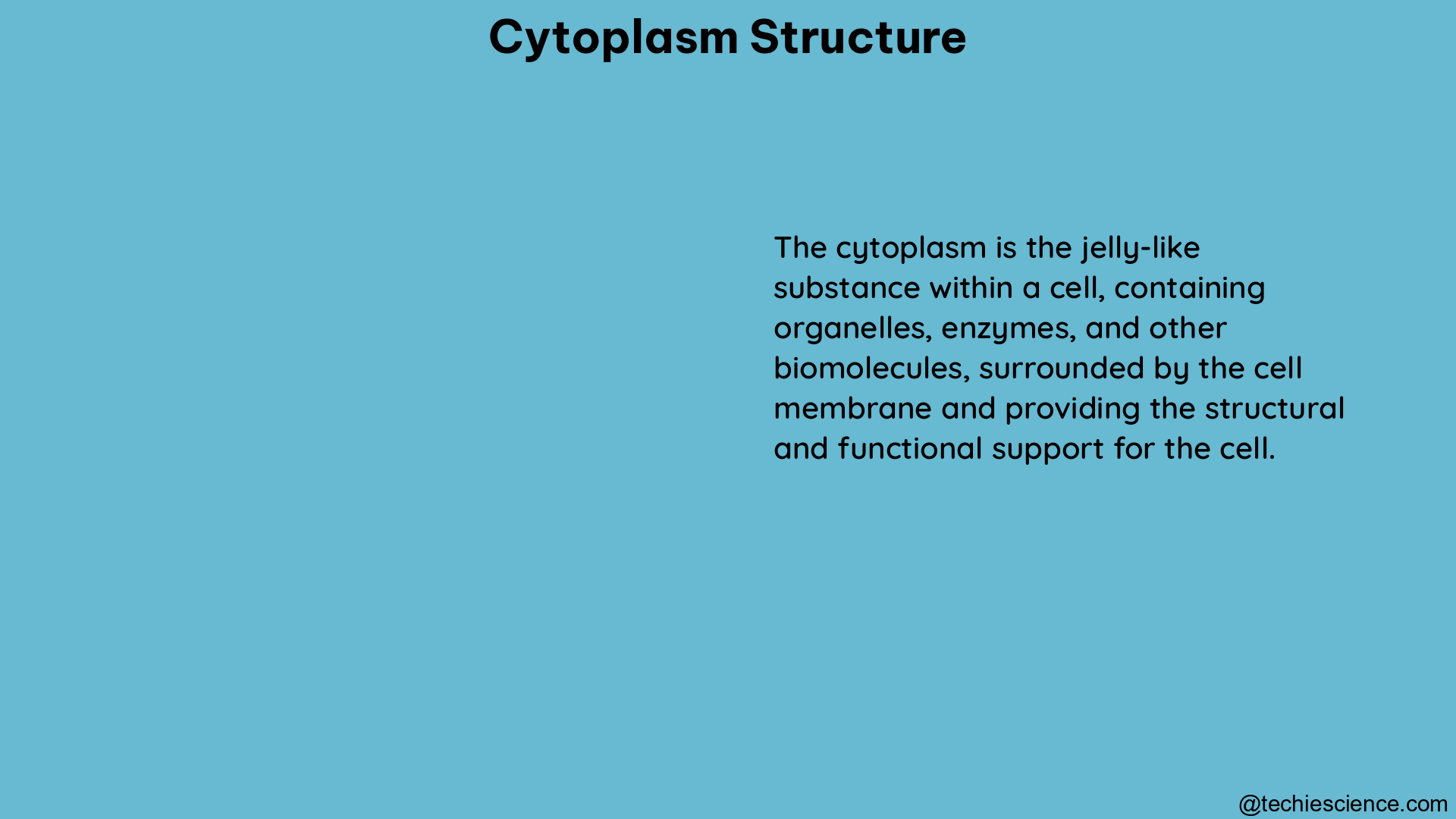The cytoplasm is the gelatinous, semi-fluid substance that fills the interior of a cell, excluding the nucleus and organelles. This complex and dynamic system is composed of a diverse array of organelles, proteins, and other molecules suspended in a fluid called the cytosol. Understanding the intricate structure and composition of the cytoplasm is crucial for comprehending cellular function and processes.
The Cytosol: The Backbone of the Cytoplasm
The cytosol, which forms the bulk of the cytoplasm, is a highly concentrated solution of up to 200,000 different small molecules, including an estimated 1,000 metabolites present in single-celled organisms like Escherichia coli and Saccharomyces cerevisiae (baker’s yeast). This aqueous medium makes up approximately 70% of the total volume of a typical cell and maintains a neutral pH of 7.4.
The Viscosity and Diffusion Dynamics of the Cytosol
Despite its water-like appearance, the viscosity of the cytoplasm is roughly the same as pure water. However, the diffusion of small molecules through this liquid is about four times slower than in pure water, primarily due to the high concentration of macromolecules present in the cytosol. These macromolecules, such as proteins and nucleic acids, create a crowded environment that impedes the free movement of smaller molecules.
The Structure and Behavior of Water in the Cytoplasm
The structure of water within the cytoplasm is not fully understood, but it is believed that approximately 5% of the water is strongly bound to solutes or macromolecules as water of solvation. The remaining majority of water is thought to have a similar structure to pure water. However, some researchers argue that the high concentrations of macromolecules in the cytosol can alter the behavior of water throughout the entire compartment, making it significantly different from water in dilute solutions.
Compartmentalization and Organization within the Cytoplasm

Although the components of the cytosol are not separated by cell membranes, they do not always mix randomly. Concentration gradients can be maintained within the cytoplasm, as evidenced by the “calcium sparks” produced around an open calcium channel, which are approximately 2 micrometers in diameter and last for only a few milliseconds.
Protein Complexes and Metabolic Pathways
Proteins can also associate to form protein complexes, which often contain a set of enzymes that carry out multiple steps in the same metabolic pathway. This organization allows for efficient and coordinated biochemical reactions within the cytoplasm.
Quantitative Analysis of Cytoplasmic Organelles
Advances in microscopy and image analysis techniques have enabled the quantitative study of cytoplasmic organelles. Automated segmentation and quantitative analysis using confocal microscopy can provide valuable insights into the number, dimensions, content, and localization of secretory organelles, such as Weibel-Palade bodies (WPBs).
Measuring Organelle Dynamics and Responses
For example, this method has been used to measure the reduction in WPB size after disruption of the Golgi apparatus and to quantify the perinuclear clustering of WPBs in response to the activation of cAMP-mediated signaling pathways in endothelial colony-forming cells (ECFCs).
The Complexity and Dynamism of the Cytoplasm
In summary, the cytoplasm is a highly complex and dynamic system, with the cytosol serving as the backbone. The cytosol is a concentrated solution of a vast array of small molecules, including an estimated 1,000 metabolites in single-celled organisms. Despite its water-like viscosity, the cytoplasm exhibits slower diffusion of small molecules due to the crowded environment created by macromolecules.
The organization and behavior of the cytoplasm are not random, as evidenced by the maintenance of concentration gradients and the formation of protein complexes. Advances in microscopy and image analysis techniques have enabled the quantitative study of cytoplasmic organelles, providing valuable insights into their dynamics and responses to various stimuli.
Understanding the intricate structure and composition of the cytoplasm is crucial for unraveling the complex mechanisms underlying cellular function and dysfunction. The continued exploration of this dynamic system will undoubtedly lead to new discoveries and advancements in the field of cell biology.
References:
– Cytosol – Wikipedia
– Quantitative analysis of organelle dynamics: A review – NCBI
– Presenting Data – Open Oregon Educational Resources

The lambdageeks.com Core SME Team is a group of experienced subject matter experts from diverse scientific and technical fields including Physics, Chemistry, Technology,Electronics & Electrical Engineering, Automotive, Mechanical Engineering. Our team collaborates to create high-quality, well-researched articles on a wide range of science and technology topics for the lambdageeks.com website.
All Our Senior SME are having more than 7 Years of experience in the respective fields . They are either Working Industry Professionals or assocaited With different Universities. Refer Our Authors Page to get to know About our Core SMEs.